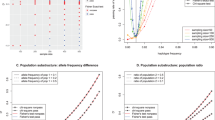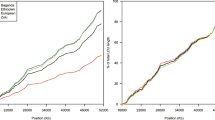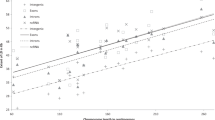Abstract
Recently, attention has focused on the use of whole-genome linkage disequilibrium (LD) studies to map common disease genes. Such studies would employ a dense map of single nucleotide polymorphisms (SNPs) to detect association between a marker and disease. Construction of SNP maps is currently underway. An essential issue yet to be settled is the required marker density of such maps. Here, I use population simulations to estimate the extent of LD surrounding common gene variants in the general human population as well as in isolated populations. Two main conclusions emerge from these investigations. First, a useful level of LD is unlikely to extend beyond an average distance of roughly 3 kb in the general population, which implies that approximately 500,000 SNPs will be required for whole-genome studies. Second, the extent of LD is similar in isolated populations unless the founding bottleneck is very narrow or the frequency of the variant is low (<5%).
This is a preview of subscription content, access via your institution
Access options
Subscribe to this journal
Receive 12 print issues and online access
$209.00 per year
only $17.42 per issue
Buy this article
- Purchase on Springer Link
- Instant access to full article PDF
Prices may be subject to local taxes which are calculated during checkout







Similar content being viewed by others
References
Risch, N. & Merikangas, K. The future of genetic studies of complex human diseases. Science 273, 1516–1517 (1996).
Lander, E.S. The new genomics: global views of biology. Science 274, 536–539 (1996).
Collins, F.S. Positional cloning moves from perditional to traditional. Nature Genet. 9, 347–350 ( 1995).
Lander, E.S. & Schork, N.J. Genetic dissection of complex traits. Science 265, 2037–2048 (1994).
Landegren, U., Nilsson, M. & Kwok, P.-Y. Reading bits of genetic information: methods for single-nucleotide polymorphism analysis. Genome Res. 8, 769 –776 (1998).
Wang, D.G. et al. Large-scale identification, mapping, and genotyping of single-nucleotide polymorphisms in the human genome. Science 280, 1077–1082 (1998).
Collins, F.S., Guyer, M.S. & Chakravarti, A. Variations on a theme: cataloging human DNA sequence variation. Science 278, 1580– 1581 (1997).
Hudson, R.R. Gene genealogies and the coalescent process. in Oxford Surveys in Evolutionary Biology (eds Futuyma, D. & Antonovics, J.) 1–44 (Oxford University Press, Oxford, 1991).
Harpending, H.C. et al. Genetic traces of ancient demography. Proc. Natl Acad. Sci. USA 95, 1961–1967 (1998).
Devlin, B. & Risch, N. A comparison of linkage disequilibrium measures for fine-scale mapping. Genomics 29, 311–322 (1995).
Kaplan, N. & Weir, B.S. Expected behavior of conditional linkage disequilibrium. Am. J. Hum. Genet. 51, 333–343 (1992).
Camp, N.J. Genomewide transmission/disequilibrium testing—consideration of the genotype relative risks at disease loci. Am. J. Hum. Genet. 61, 1424–1430 (1998).
Jorde, L.B. Linkage disequilibrium as a gene-mapping tool. Am. J. Hum. Genet. 56, 11–14 ( 1995).
Clark, A.G. et al. Haplotype structure and population-genetics inferences from nucleotide-sequence variation in human lipoprotein lipase. Am. J. Hum. Genet. 63, 595–612 (1998).
Muller-Myhsok, B. & Abel, L. Genetic analysis of complex diseases. Science 275, 1328– 1329 (1998).
Reich, D.E. & Goldstein, D.B. Genetic evidence for a Paleolithic human population explosion in Africa. Proc. Natl Acad. Sci. USA 95, 8119–8123 ( 1998).
Takahata, N. Allelic genealogy and human evolution. Mol. Biol. Evol. 10, 2–22 (1993).
Ayala, F.J. The myth of Eve: molecular biology and human origins. Science 270, 1930–1936 (1995).
Hastbacka, J. et al. Linkage disequilibrium mapping in isolated founder populations: diastrophic dysplasia in Finland. Nature Genet. 2, 204–211 (1992).
Robertson, A. & Hill, W.G. Population and quantitative genetics of many linked loci in finite populations. Proc. R. Soc. Lond. B Biol. Sci. 219, 253–264 (1983).
Chapman, N.H. & Wijsman, E.M. Genome screens using linkage disequilibrium tests: optimal marker characteristics and feasibility. Am. J. Hum. Genet. 63, 1872–1885 ( 1998).
Thompson, E.A. & Neel, V.J. Allelic disequilibrium and allele frequency distribution as a function of social and demographic history. Am. J. Hum. Genet. 60, 197– 204 (1997).
Terwilliger, J.D., Zollner, S., Laan, M. & Paabo, S. Mapping genes through the use of linkage disequilibrium generated by genetic drift: "drift mapping" in small populations with no demographic expansion. Hum. Hered. 48, 138–154 ( 1998).
Collins, F.S. et al. New goals for the U.S. human genome project: 1998-2003. Science 282, 682–689 ( 1998).
Li, W.-H. Molecular Evolution (Sinauer, Sunderland, 1997).
Carlson, C.S. & Cox, D.R. Linkage disequilibrium of SNPs on human chromosome 21. Am. J. Hum. Genet. 63, A 284 (1998).
Lai, E., Riley, J., Purvis, I. & Roses, A. A 4-Mb high-density single nucleotide polymorphism-based map around human APOE. Genomics 54, 31–38 ( 1998).
Hudson, R.R. Properties of a neutral allele model with intragenic recombination. Theor. Popul. Biol. 23, 183–201 (1983).
Hudson, R.R. The sampling distribution of linkage disequilibrium under an infinite allele model without selection. Genetics 109, 611 –631 (1985).
Hudson, R.R. The how and why of generating gene genealogies. in Mechanisms of Molecular Evolution (eds Takahata, N. & Clark, A.G.) 23– 36 (Sinauer, Sunderland, 1992).
Donnelly, P. & Tavare, S. Coalescents and genealogical structure under neutrality. Annu. Rev. Genet. 29, 40–421 (1995).
Acknowledgements
This work grew out of conversations with E. Lander, and I am grateful for his advice and encouragement. I thank D. Altshuler, K. Ardlie, M. Cargill, H. Coller, G. Daley, M. Daly, M. Eberle, J. Felsenstein, S. Kruglyak, S.-N. Liu, K. Markianos, D. Slonim, D. Wang and E. Wijsman for helpful discussions and comments on the manuscript, and M. Eberle for invaluable assistance with simulations and figure preparation. The paper benefited from discussion during a meeting on SNPs held at the Banbury Center and from comments of anonymous referees. This work was supported in part by grants from NHGRI and NIMH. L.K. is a James S. McDonnell Centennial Fellow.
Author information
Authors and Affiliations
Rights and permissions
About this article
Cite this article
Kruglyak, L. Prospects for whole-genome linkage disequilibrium mapping of common disease genes. Nat Genet 22, 139–144 (1999). https://doi.org/10.1038/9642
Received:
Accepted:
Issue Date:
DOI: https://doi.org/10.1038/9642
This article is cited by
-
Genetic insights into crossbred dairy cattle of Pakistan: exploring allele frequency, linkage disequilibrium, and effective population size at a genome-wide scale
Mammalian Genome (2023)
-
Association analysis of germination level cold stress tolerance and candidate gene identification in Upland cotton (Gossypium hirsutum L.)
Physiology and Molecular Biology of Plants (2022)
-
Further insight into the global variability of the OCA2-HERC2 locus for human pigmentation from multiallelic markers
Scientific Reports (2021)
-
Molecular mapping of QTLs for fiber quality traits in Gossypium hirsutum multi-parent recombinant inbred lines
Euphytica (2021)
-
A local score approach improves GWAS resolution and detects minor QTL: application to Medicago truncatula quantitative disease resistance to multiple Aphanomyces euteiches isolates
Heredity (2019)



